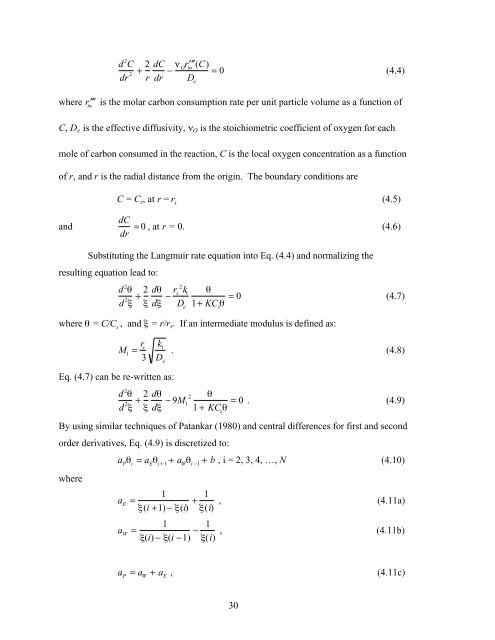MODELING CHAR OXIDATION AS A FUNCTION OF PRESSURE ...
MODELING CHAR OXIDATION AS A FUNCTION OF PRESSURE ...
MODELING CHAR OXIDATION AS A FUNCTION OF PRESSURE ...
You also want an ePaper? Increase the reach of your titles
YUMPU automatically turns print PDFs into web optimized ePapers that Google loves.
d 2 C 2 dC<br />
2 +<br />
dr r dr<br />
O ′ ′ − r in (C)<br />
= 0 (4.4)<br />
De where r in ′ is the molar carbon consumption rate per unit particle volume as a function of<br />
C, D e is the effective diffusivity, O is the stoichiometric coefficient of oxygen for each<br />
mole of carbon consumed in the reaction, C is the local oxygen concentration as a function<br />
of r, and r is the radial distance from the origin. The boundary conditions are<br />
and<br />
C = C s, at r = r s<br />
dC<br />
dr<br />
30<br />
(4.5)<br />
= 0 , at r = 0. (4.6)<br />
Substituting the Langmuir rate equation into Eq. (4.4) and normalizing the<br />
resulting equation lead to:<br />
d 2<br />
2 d<br />
2 +<br />
d d − r 2<br />
s<br />
k1<br />
De 1+ KCs = 0 (4.7)<br />
where = C/C s , and = r/r s. If an intermediate modulus is defined as:<br />
M 1 = r s<br />
3<br />
k 1<br />
D e<br />
Eq. (4.7) can be re-written as:<br />
d 2<br />
2 d<br />
2 +<br />
d d − 9M 2<br />
1<br />
1 + KCs . (4.8)<br />
= 0 . (4.9)<br />
By using similar techniques of Patankar (1980) and central differences for first and second<br />
order derivatives, Eq. (4.9) is discretized to:<br />
where<br />
a P i = a E i + 1 + a W i −1 + b , i = 2, 3, 4, …, N (4.10)<br />
a E =<br />
a W =<br />
1 1<br />
+<br />
(i +1) − (i) (i)<br />
1 1<br />
−<br />
(i) − (i −1) (i)<br />
, (4.11a)<br />
, (4.11b)<br />
a P = a W + a E , (4.11c)
















